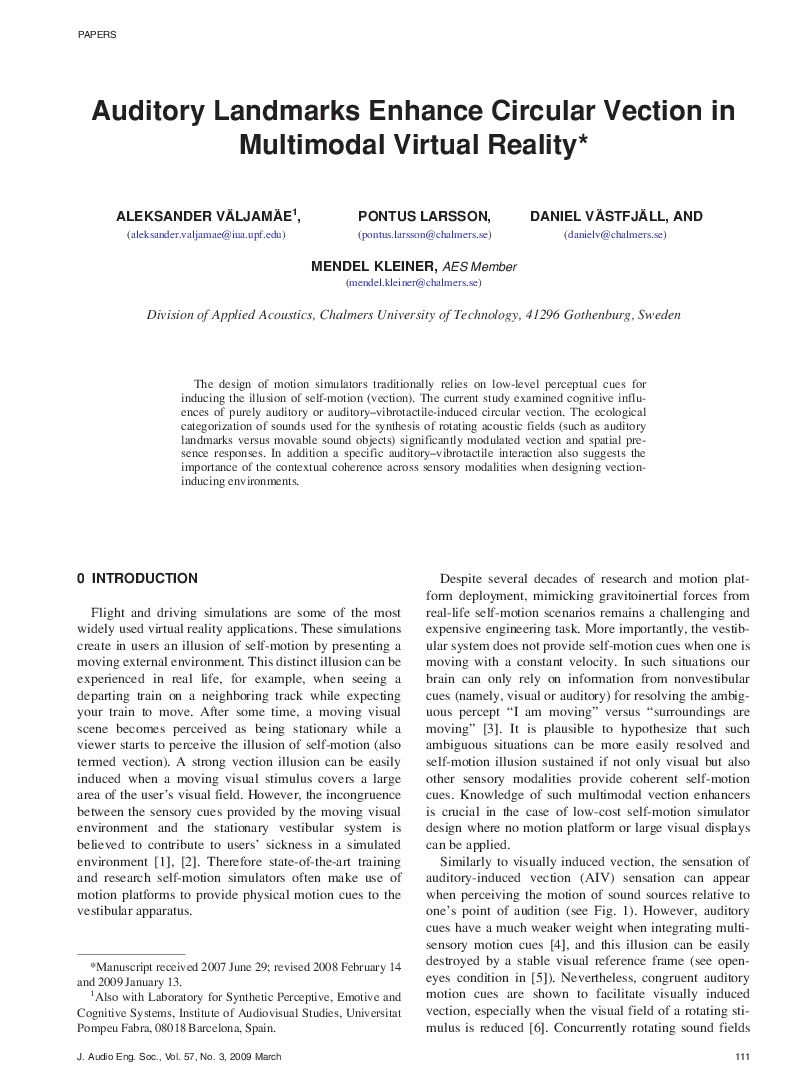Home / Publications / E-library page
You are currently logged in as an
Institutional Subscriber.
If you would like to logout,
please click on the button below.
Home / Publications / E-library page
Only AES members and Institutional Journal Subscribers can download
The means by which an individual distinguishes between (a) self-movement relative to a fixed external object and (b) a fixed sense of self relative to a moving object involves both sensory input and cognitive processes. The current study examines the cognitive influences of an auditory presentation on the illusion of motion. The illusion of self-motion was strongest when simulating multiple auditory objects of the type that are expected to be immobile: acoustic landmarks. The effect is strongest without visual cues, which can dominate if present. The addition of vibrotactile stimulation of the whole body was only selectively contributing to the experience of being in motion depending on the simulated auditory objects.
Author (s): Väljamäe, Aleksander; Larsson, Pontus; Västfjäll, Daniel; Kleiner, Mendel
Affiliation:
Division of Applied Acoustics, Chalmers University of Technology, Gothenburg, Sweden
(See document for exact affiliation information.)
Publication Date:
2009-03-06
Import into BibTeX
Permalink: https://aes2.org/publications/elibrary-page/?id=14809
(1092KB)
Click to purchase paper as a non-member or login as an AES member. If your company or school subscribes to the E-Library then switch to the institutional version. If you are not an AES member Join the AES. If you need to check your member status, login to the Member Portal.

Väljamäe, Aleksander; Larsson, Pontus; Västfjäll, Daniel; Kleiner, Mendel; 2009; Auditory Landmarks Enhance Circular Vection in Multimodal Virtual Reality [PDF]; Division of Applied Acoustics, Chalmers University of Technology, Gothenburg, Sweden; Paper ; Available from: https://aes2.org/publications/elibrary-page/?id=14809
Väljamäe, Aleksander; Larsson, Pontus; Västfjäll, Daniel; Kleiner, Mendel; Auditory Landmarks Enhance Circular Vection in Multimodal Virtual Reality [PDF]; Division of Applied Acoustics, Chalmers University of Technology, Gothenburg, Sweden; Paper ; 2009 Available: https://aes2.org/publications/elibrary-page/?id=14809
@article{väljamäe2009auditory,
author={väljamäe aleksander and larsson pontus and västfjäll daniel and kleiner mendel},
journal={journal of the audio engineering society},
title={auditory landmarks enhance circular vection in multimodal virtual reality},
year={2009},
volume={57},
issue={3},
pages={111-120},
month={march},}